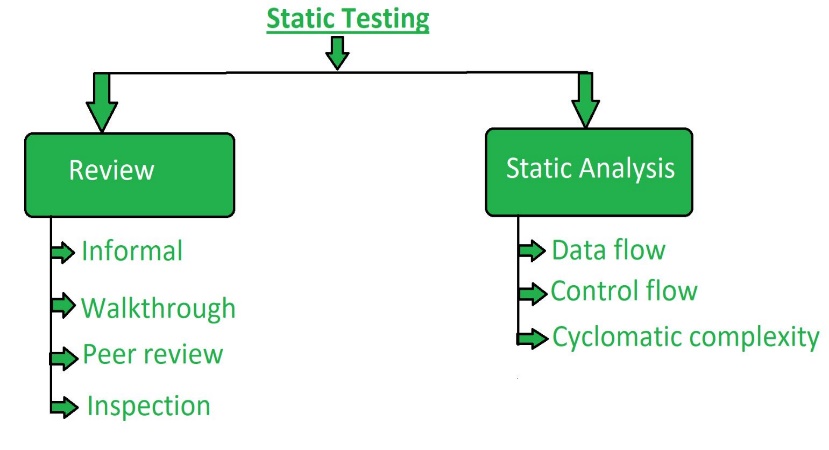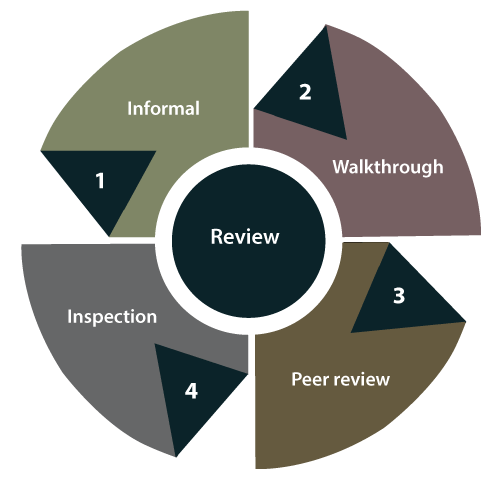Back to: Software Testing Tutorials
Static Testing
In this article, I am going to discuss Static Testing. Please read our previous article where we discussed Sanity Testing. At the end of this article, you will understand the following important pointers which are related to Static Testing.
- What is Static Testing?
- Why is it Necessary to Conduct Static Testing?
- Why Do Static Tests?
- What are the Objectives of Static Testing?
- Explain Static Testing Techniques
- What Various Functionalities can we Test using Static Testing?
- Why is Static Testing Needed?
- How to Conduct Static Testing?
- Example of Static Testing
- Which tools are used in Static Testing?
- What are the Advantages of Static Testing?
- What are the Disadvantages of Static Testing?
What is Static Testing?
Software testing methods like static testing are used to find bugs in programs without actually running their source code. While during Dynamic Testing tests, the code is run in order to find the errors. Static testing is carried out in the early stages of development to prevent errors because it is simpler to identify the causes of failures and rectify them.
Simple static testing can find errors that dynamic testing cannot. Static testing is a method of testing software that involves studying the documentation, design, or code without actually running the program. It is a method of studying the program in a “static” state rather than actively running it in order to check for problems and flaws.
Static testing seeks to find problems early in the software development process, when fixing them will be simpler and less expensive. Static testing can assist increase the overall quality and dependability of the product by identifying flaws early. Additionally, it improves maintainability and, in the long run, saves time and money.
Why is it Necessary to Conduct Static Testing?
Static testing can be done to satisfy the following requirements:
- Static testing can help us increase development productivity.
- We could uncover the issues in the early stages and quickly correct them if we performed static testing on an application.
- Static testing will cut down on testing expenses and lengthen development cycles.
Why Do Static Tests?
Static testing is appropriate for the following reasons:
- Early identification and rectification of defects.
- Shorter development times.
- Decreased testing time and costs to increase development productivity.
- To produce fewer problems during a later testing phase.
What are the Objectives of Static Testing?
Static testing’s key objectives are as follows:
- Static testing will cut down on manufacturing flaws.
- Static testing will find, foresee, and correct the errors as soon as possible.
- It is used to cut costs and save time.
- Defects are found early in the SDLC process when they are still simple to rectify.
Explain Static Testing Techniques
Techniques for static testing are an excellent approach to improving the effectiveness and caliber of software development. There are two ways to use the static testing technique, which are as follows:

Review:
Static testing uses the process or technique of evaluation to identify any potential flaws in the software’s design. It is a procedure to find and fix mistakes and flaws in various supporting papers, such as software requirements specifications. The documents were examined, and mistakes, repetitions, and ambiguities were removed. Reviews come in four varieties:

- Informal: In an informal review, the author of the document presents the contents to the audience and invites feedback. As a result, errors are found early on.
- Walkthrough: This is essentially done by an expert or experienced individual to check for errors so that there won’t be any issues later on during the development or testing process.
- Peer review: Peer review is the process of examining each other’s documents to find and correct errors. In essence, a group of coworkers completes it.
- Inspection: Inspection is essentially the process of having a document verified by a higher authority, such as the software requirement specifications (SRS).
Static Analysis:
The static analysis comprises assessing the caliber of developer-written code. In order to analyze the code and compare it to the standard, many tools are utilized. It aids in the discovery of the following flaws as well:
- Unused variables
- Dead code
- Infinite loops
- Variable with undefined value
- Wrong syntax

- Data Flow: Stream processing is connected to data flow.
- Control Flow: The process by which the assertions or instructions are carried out is known as control flow.
- Cyclomatic Complexity: The number of independent paths in the control flow graph created from the code or flowchart is defined by cyclomatic complexity, allowing for the creation of a minimum number of test cases for each independent path.
What Various Functionalities can we Test using Static Testing?
In Static Testing, we can test the following different testing activities:
- Business Requirements Document
- Unit Use Cases
- Prototype
- Prototype Specification Document
- Test Data
- DB Fields Dictionary Spreadsheet
- Documentation/Training Guides/User Manual
- Test Cases/Test Plan Strategy Document
- Traceability Matrix Document
- Performance Test Scripts/Automation
Why is Static Testing Needed?
Whenever we come across one of the following circumstances while evaluating an application or piece of software, static testing is required:
- Time-consuming Dynamic Testing: Static testing is necessary to test the application because dynamic testing takes a long time even if it can find bugs and give some information about them.
- Early-stage flaws and bug identification: Dynamic testing cannot be totally relied upon when developing software because it identifies application or software flaws at a later stage when it will be more difficult and time-consuming for the programmer to correct them.
- The cost of dynamic testing is high: Because dynamic testing is more expensive than static testing, we must conduct static testing on the software product. Since the test cases have already been produced, including them in dynamic testing is expensive. Additionally, the test engineers must devote a lot of time to maintaining the implementation and validation of the test case.
- Larger software footprint: Every time we test the software, the product’s size increases, which we cannot manage due to the decline in code coverage productivity.
How to Conduct Static Testing?
Static testing is carried out in the following ways:
Implement the inspection process to look over the application’s design in-depth.
Use a checklist for each document being checked to ensure sure all reviews are finished.
The numerous tasks involved in static testing include:
- Validation of Use Cases Requirements: This ensures that all end-user actions, along with any associated inputs and outputs, have been correctly recognized. The more detailed and exact the use cases, the more accurate and complete the test cases may be.
- Validation of Functional Requirements: This process makes sure that all essential components are mentioned in the functional requirements. It also looks at database functionality, hardware, software, and network requirements, as well as interface listings.
- Architecture Review: All business-level processes, including server locations, network diagrams, protocol definitions, load balancing, database accessibility, test tools, etc., are reviewed in the architecture.
- Prototype/Screen Mockup Validation: Validation of the prototype or screen mockup: This phase involves checking the requirements and use cases.
- Field Dictionary Validation: Every field in the user interface is sufficiently defined to support the creation of test cases for field-level validation. Fields’ minimum/maximum lengths, list values, error messages, etc., are examined.
Example of Static Testing
Consider that your team’s development team is working on a feature that will move certain users to a different server if the number of users on one server rises above a certain level. Let’s imagine the development team has attempted to address every scenario, but they haven’t created a plan for how to restore user access in the event of a sudden second server failure. A tester will be able to identify this type of problem relatively early, in the documentation stage, by studying the design specifications of the feature.
Which tools are used in Static Testing?
Here are a few resources:
- Checkstyle: This static analysis tool aids in upholding Java coding standards. It can impose standards like naming conventions, code formatting, and other best practices in addition to scanning code for errors.
- SourceMeter: For the analysis of software systems and the detection of potential flaws and vulnerabilities, SourceMeter is a potent source code analysis platform. It can examine code written in a variety of programming languages and generate reports that help developers make defensible choices.
- Soot: This Java optimization system, known as Soot, includes a number of tools for analysis and modification. By identifying unused code and enhancing overall code quality, it can speed up code execution.
What are the Advantages of Static Testing?
Static testing in software testing offers several advantages:
- Early defect detection: Identifying issues at the requirement and design stages reduces costs and effort.
- Improved quality: Uncovering defects before implementation ensures a higher-quality end product.
- Enhanced collaboration: Involving stakeholders early fosters better communication and understanding.
- Time and cost efficiency: Fixing defects early is more cost-effective than later in the development lifecycle.
- Reduced rework: Catching defects beforehand reduces the need for extensive rework.
What are the Disadvantages of Static Testing?
Static testing in software testing refers to the examination of software artifacts without executing the code. While it has its merits, it also has certain disadvantages:
- Limited coverage: Static testing can’t identify all runtime errors or dynamic behavior.
- Human errors: Human reviewers may miss defects due to oversight or subjectivity.
- Time-consuming: Manual reviews can be time-consuming, impacting the overall development timeline.
- Incomplete understanding: Testers might not grasp the entire code, leading to inaccurate evaluations.
- Lack of execution environment: Static testing doesn’t consider specific runtime conditions.
In the next article, I am going to discuss Dynamic Software Testing. Here, in this article, I try to explain Static Software Testing. I hope you enjoy this Static Software Testing article.
